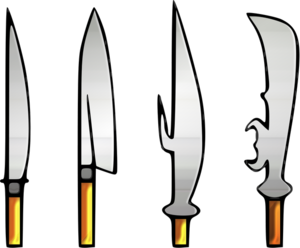Difference between revisions of "Glaive"
(jump ahead a bit to resolve the encyc redirect thing) (Tag: Removed redirect) |
(begin on origin stuff - glaive article on WP feel like a lotta fluffy nothing compared to the halberd) |
||
| Line 26: | Line 26: | ||
==History== | ==History== | ||
| − | The | + | The glaive is introduced with all other polearms in [[NetHack 1.3d]]. |
==Origin== | ==Origin== | ||
{{wikipedia}} | {{wikipedia}} | ||
[[Image:Glaives-Colored.png|thumb|right]] | [[Image:Glaives-Colored.png|thumb|right]] | ||
| + | A glaive, sometimes spelled as glave, is a type of pole weapon with historical origins in Europe, and is known for its distinctive design and versatile combat applications. It is compared to other polearms such as the war scythe and the Japanese ''naginata''. A glaive typically consists of a single-edged blade approximately 45 centimeters long, affixed to a pole measuring about 2 meters in a socket-shaft configuration akin to an axe head - some glaive blades were even forged with a small hook on the reverse side to better engage mounted opponents, earning them the name "glaive-guisarmes." | ||
| + | |||
| + | Historical records suggest that the glaive may have originated in Wales, where it was a national weapon until the late 15th century: there is a mention of a warrant from the first year of Richard III's reign, dated 1483, for the production of "two hundred Welsh glaives". Glaives were used by infantry and could be particularly effective against mounted opponents. | ||
| + | |||
| + | {{wikipedia|Naginata}} | ||
[[Image:Naginata.png|thumb|right]] | [[Image:Naginata.png|thumb|right]] | ||
| − | |||
==Encyclopedia entry== | ==Encyclopedia entry== | ||
Revision as of 06:27, 11 April 2024
| ) | |
|---|---|
| Name | glaive |
| Appearance | single-edged polearm |
| Damage vs. small | d6 |
| Damage vs. large | d10 |
| To-hit bonus | +0 |
| Weapon skill | polearm |
| Size | two-handed |
| Base price | 6 zm (+10/positive enchant) |
| Weight | 75 |
| Material | iron |
A glaive is a type of weapon that appears in NetHack. It is a two-handed polearm that is made of iron, and appears as a single-edged polearm when unidentified.
For Samurai, the glaive appears as a naginata.
Contents
Generation
In addition to random generation, general shops and antique weapons outlets can sell glaives.
Watchmen and soldiers may be generated with a glaive.[1] Trolls have an effective 1⁄8 chance of being generated with a glaive.[2]
Strategy
The glaive is among the more common polearms that can be found, and is the third-lightest at 75 aum, but is weaker in terms of average damage compared to other lighter polearms.
History
The glaive is introduced with all other polearms in NetHack 1.3d.
Origin
A glaive, sometimes spelled as glave, is a type of pole weapon with historical origins in Europe, and is known for its distinctive design and versatile combat applications. It is compared to other polearms such as the war scythe and the Japanese naginata. A glaive typically consists of a single-edged blade approximately 45 centimeters long, affixed to a pole measuring about 2 meters in a socket-shaft configuration akin to an axe head - some glaive blades were even forged with a small hook on the reverse side to better engage mounted opponents, earning them the name "glaive-guisarmes."
Historical records suggest that the glaive may have originated in Wales, where it was a national weapon until the late 15th century: there is a mention of a warrant from the first year of Richard III's reign, dated 1483, for the production of "two hundred Welsh glaives". Glaives were used by infantry and could be particularly effective against mounted opponents.
Encyclopedia entry
Glaive
- See the encyclopedia entry for polearm.
Naginata
A Japanese pole-arm, fitted with a curved single-edged blade.
The blades ranged in length from two to four feet, mounted on
shafts about four to five feet long. The naginata were cut
with a series of short grooves near to the tang, above which
the back edge was thinned, but not sharpened, so that the
greater part of the blade was a flattened diamond shape in
section. Seen in profile, the curve is slight or non-
existent near the tang, becoming more pronounced towards the
point.
"With his naginata he killed five, but with the sixth it
snapped asunder in the midst and, flinging it away, he drew
his sword, wielding it in the zigzag style, the interlacing,
cross, reversed dragonfly, waterwheel, and eight-sides-at-
once styles of fencing and cutting down eight men; but as he
brought down the ninth with a mighty blow on the helmet, the
blade snapped at the hilt."

